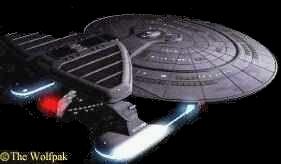
NEBULA CLASS

|
Type: |
Explorer |
|
Commissioned: |
2355 - present |
|
Dimensions: |
|
|
Length: |
433 m |
|
Beam: |
560 m |
|
Height: |
145 m |
|
Decks: |
42 (including pod) |
|
Mass: |
4,500,000 tons |
|
Crew: |
780 including family members |
|
Armament: |
8 x Type X Phaser arrays, total output 32,500 TeraWatts |
|
3 x Type 3 burst fire photon torpedo tubes + 180 torpedoes |
|
|
Antimatter spread emitter |
|
|
Defense Systems: |
High capacity shield system, total capacity 2,349,000 TeraJoules |
|
Standard Duranium/Tritanium double hull plus 8.0 cm High Density armor |
|
|
Standard level Structural Integrity Field |
|
|
Warp Speeds: |
Normal Cruise: Warp 6 |
|
(TNG Scale) |
Maximum Cruise: Warp 9 |
|
Maximum Rated: Warp 9.4 for twelve hours |
|
|
Strength Indices: |
Beam Firepower: 950 |
|
(Galaxy Class = 1000) |
Torpedo Firepower: 2000 |
|
Weapon Range & Accuracy: 1020 |
|
|
Shield Strength: 880 |
|
|
Hull Armor: 1000 |
|
|
Speed: 890 |
|
|
Combat Maneuverability: 1150 |
|
|
Overall Strength Index: 1230 |
|
|
Diplomatic Capability: |
Grade 1 |
|
Expected Hull Life: |
100 years |
|
Refit Cycle: |
Minor: 1 year |
|
Standard: 5 years |
|
|
Major: 20 years |
|
|
Added Features: |
The Nebula class was fielded in the 2350's to provide a smaller, more numerous counterpart to the Galaxy class then under construction. The design was intended to parallel that of the Galaxy class as closely as possible in order to allow for many identical systems to be installed in both classes; this has resulted in significant improvements in the design and construction processes for the Nebula class and thus allowed comparatively high numbers to be fielded. Compared to the Galaxy class the Nebula has a more compact shape - the engineering hull is mounted directly to the underside of the saucer section, a measure which saves some 200 metros in length |
|
The major difference in capability is the addition of a prominent housing aft of the saucer section of the Nebula class. This enables the vessel to carry any one of a variety of special equipment pods - current models include a high capacity sensor pod, an enhanced weapons pod, a colony transport pod, an emergency field hospital unit, or a science laboratory pod. Although the basic Nebula design has approximately 80% of the capability of a Galaxy class vessel in most areas, the addition of the mission pod brings that figure up to 95% or more in that specific area. This flexibility actually allows the Nebula design to accomplish almost identical missions despite its smaller size |
|
|
In service the Nebula class has proved highly satisfactory, and in many ways these ships form the backbone of Starfleet's exploratory and scientific programs. Like the Galaxy class they have received regular upgrades to their systems, most notably a new Warp Core design. With the advent of the threats from the Romulan, Dominion and Borg, Starfleet invested in sixty seven new enhanced weapon pods for the Nebula class; most of the vessels now carry this as a standard item |
Home
Crew Intel Office Aliens Ships Technology Protocols General Orders Directives